No products in the cart.
June 23, 2024 11:52 am
June 23, 2024 11:52 am
In the rich tapestry of Norse mythology, Odin stands as a paramount figure, revered not only as the chief deity but also as a symbol of wisdom, war, and magic.
Accompanying him are Geri and Freki, two wolves whose names translate from Old Norse as “the greedy one” and “the ravenous one.”
These creatures are far more than mere companions; they are integral to Odin’s image as the all-seeing god of the Norse pantheon.
Odin’s relationship with Geri and Freki brings into focus the complex interplay between divine entities and their animal counterparts in Viking lore, highlighting themes of loyalty, power, and the primal instincts that underlie the civilized façades of gods and men alike.
This narrative not only captures the imagination of those who cherish Viking history but also resonates deeply with individuals drawn to the mystical aspects of Norse paganism.
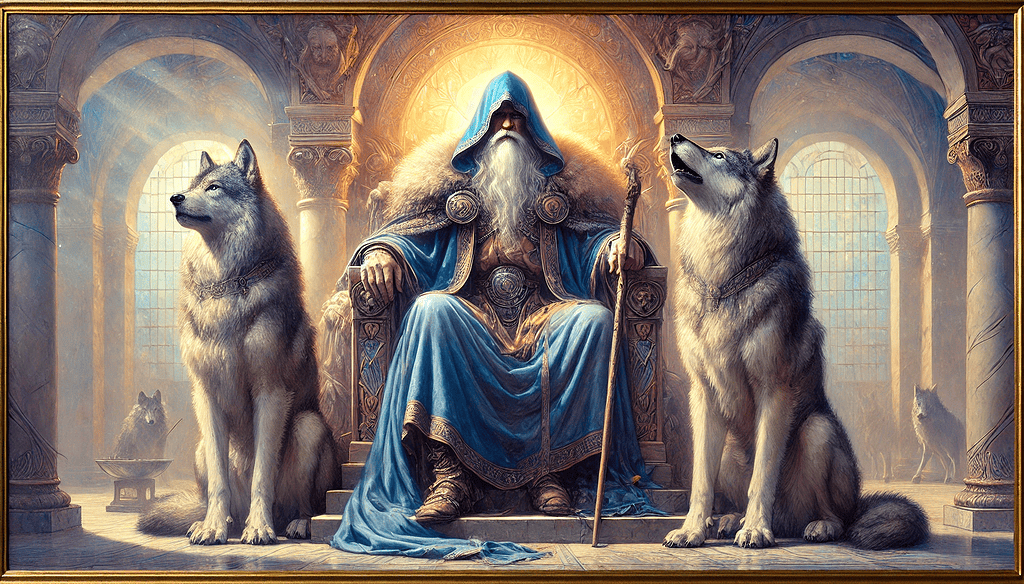
Geri and Freki, whose names starkly mean “the greedy one” and “the ravenous one,” serve as profound symbols within Norse mythology. These names not only reflect their roles as beings of substantial appetite and desire but also echo the deep-seated themes of voracity and survival that permeate the ancient Norse worldview.
The dual nature of these wolves—both fearsome and revered—enhances our understanding of how the Norse people envisioned the world around them, one where the lines between the wild and the divine are intricately intertwined.
Unlike typical depictions of animal companionship, Geri and Freki are not merely pets that roam the halls of Valhalla. They are essential to Odin’s presence as a god who straddles the worlds of life and death, war and wisdom, magic and the mundane.
These wolves are ever-present at Odin’s side, embodying the dual aspects of his godly duties—protectors and predators, embodying the harsh realities of life and survival in the Viking Age.
In the Norse pantheon, animals often serve as vital links between the gods and the natural world, and Geri and Freki are prime examples of this connection.
Their presence alongside Odin during his ventures in the realms of men and gods alike signifies their importance as more than just companions; they are potent symbols of his power and reach.
Odin feeds them the flesh of fallen warriors from the feasts of Valhalla, highlighting a profound ritual of sacrifice and sustenance, underscoring the themes of death, valor, and the cycle of life central to Viking beliefs.
The portrayal of Geri and Freki in sagas and stories isn’t just for dramatic effect. They enhance Odin’s image as a god who is ever-prepared for battle, a ruler among the dead, and a sage in the halls of the divine.
The wolves’ fierce loyalty and formidable presence complement Odin’s multifaceted nature, portraying him as a ruler who is as nurturing as he is fearsome, as connected to the primal forces of nature as he is to the spiritual and mystical realms.
This comprehensive view of Geri and Freki enriches our understanding of Norse mythology, offering insights into the profound symbology embedded within the ancient Norse psyche and its representation of divine entities.
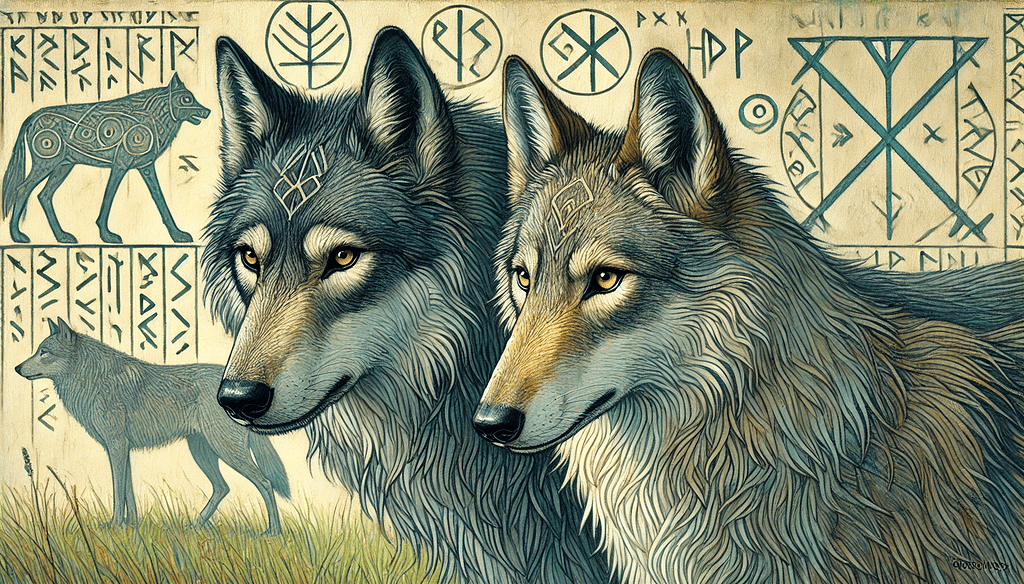
Geri and Freki, beyond their immediate presence as Odin’s companions, embody elements of his divine persona. As figures of greed and ravenousness, they mirror Odin’s insatiable quest for knowledge and his formidable prowess in battle.
This symbolism extends to depicting Odin not just as a war god but as a deity whose voracious pursuit of wisdom and understanding is as relentless as his wolves’ hunger.
The essence of hunting, a critical aspect of Viking life, is vividly embodied in Geri and Freki’s characteristics. They represent the necessity and the thrill of the hunt, reflecting the environment in which the Norse people thrived.
These wolves symbolize not only physical hunting but also the metaphysical hunt—Odin’s unending quest for cosmic secrets and existential truths.
In the heart of Viking battle ethos, Geri and Freki stand as symbols of protection and ferocity. Their presence at Odin’s side during feasts in Valhalla, where fallen warriors are honored, underscores their role as loyal companions and protectors of Odin.
This imagery resonates deeply with the Norse value of loyalty and the protective nature attributed to those who serve faithfully.
Through Geri and Freki, one can explore how the Vikings viewed the interconnection between the natural world and the spiritual realms.
These wolves are not mere animals; they are potent symbols intertwined with the cultural fabric of the Norse, representing the harmonious and sometimes harsh relationships between man, beast, and the divine.
In Norse mythology, dualities are often explored through characters and their traits. Geri and Freki epitomize this concept, representing both the benevolent and malevolent forces that Odin himself wields.
Their loyalty and ferocity, their role in sustaining Odin through the meat of heroes, all reflect the complex nature of life, death, and divine will in Norse lore.
This analysis of Geri and Freki offers a profound insight into the symbolic layers that define not only these mythical wolves but also the culture that revered them.
They are emblematic of the deeply woven threads of survival, warfare, spirituality, and the pursuit of knowledge that characterize Norse mythology.
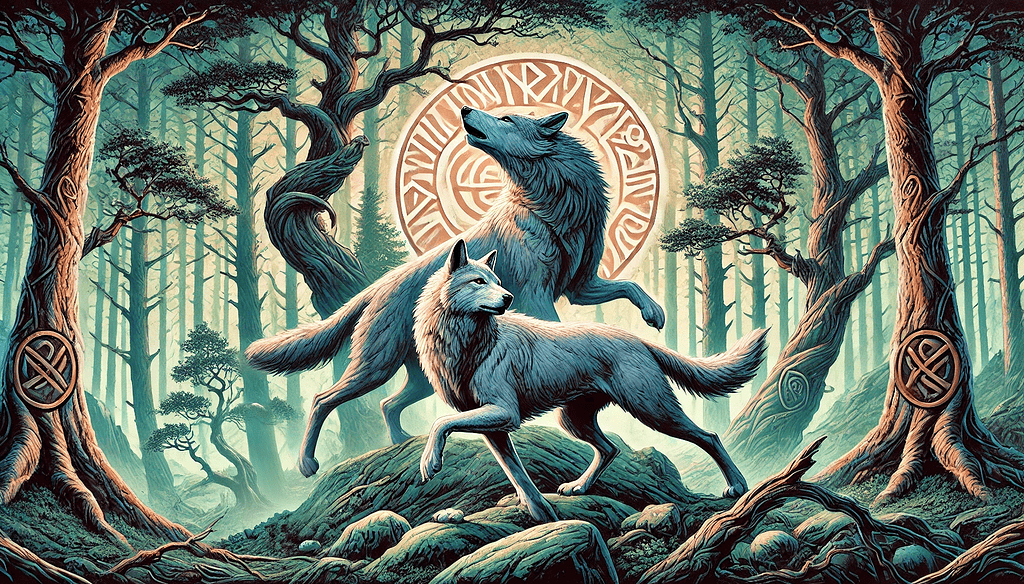
Geri and Freki are omnipresent figures at Odin’s side, particularly within the majestic halls of Valhalla, where they assume roles that are both symbolic and literal.
While Odin presides over the souls of the slain warriors, his wolves are fed the flesh of these warriors, symbolizing their integral role in the divine narrative.
This constant presence reinforces their image as loyal companions and emphasizes the themes of loyalty and protection that are pivotal in Norse mythology.
In myths where the gods convene to discuss the fates of men and gods alike, Geri and Freki are often depicted lounging at Odin’s feet, underscoring their role in the divine governance of the cosmos.
Their silent presence at such gatherings speaks volumes about their integral role in the Norse divine landscape, subtly indicating that they are privy to the godly deliberations and secrets.
Beyond their physical depictions, Geri and Freki are imbued with deeper religious and cultural symbolism. They feature in rituals and are often invoked in tales that teach lessons about the balance of power, the importance of wisdom, and the inevitability of fate.
These stories typically showcase the wolves not just as companions of Odin but as active participants in the broader narrative tapestry of Norse life and spirituality.
In some tales, Geri and Freki are portrayed as more than physical beings; they are manifestations of natural and spiritual forces. In these narratives, they sometimes appear to mortals, particularly warriors, as omens or guides.
Their appearances are regarded as signs from Odin himself, often interpreted as messages related to war and fate.
Their subtle yet significant influence extends into the myths where they interact directly with other characters, serving as both observers and enforcers of Odin’s will.
Through these interactions, Geri and Freki are depicted as more than mere animals; they are dynamic characters who contribute to the unfolding of mythic events, demonstrating the interconnectedness of all beings in the realm of Norse gods.
This exploration of Geri and Freki’s roles within Norse myths highlights their multifaceted significance and their active participation in the divine and mortal realms, embodying the complex interplay of natural instinct, divine duty, and the sacred lore of the Norse people.
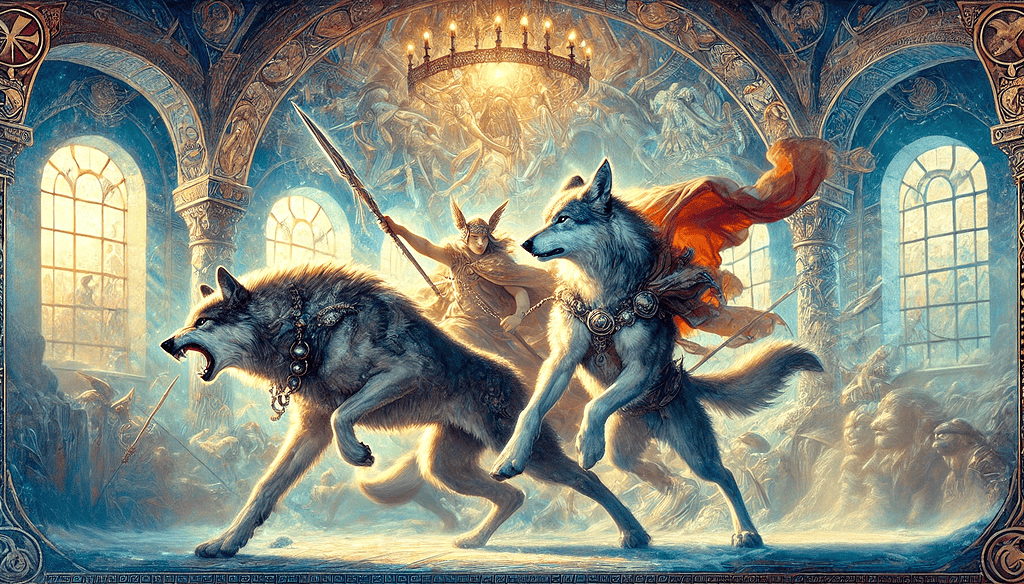
Geri and Freki occupy a distinctive place within the Poetic Edda, one of the primary sources of Norse mythology.
These texts portray them not merely as Odin’s companions but as integral elements of his godly persona. In stanzas that mention them, they are typically at Odin’s side, symbolizing his roles as the god of war and death.
This repeated imagery reinforces their importance in the Norse cosmic hierarchy and highlights their connection to the essential attributes of their master.
In the broader Norse sagas, Geri and Freki are not as prominently featured as in the Poetic Edda. They are primarily known from the Poetic Edda and the Prose Edda, where their roles are more symbolic and less interactive with other figures.
Their presence underscores themes of loyalty and readiness, reflecting the Norse belief in the intertwining of earthly and divine activities.
Analyzing their roles across these ancient texts reveals a complex layer of symbolism associated with Geri and Freki.
They are not only seen as extensions of Odin’s will but also as embodiments of the wild, untamed forces of nature that Odin, as a god, governs and represents. This dual portrayal resonates deeply with themes of power, control, and the natural order within the Norse mythological framework.
The appearances of Geri and Freki in these texts often serve to foreshadow events or underscore the moral and thematic undertones of the tales.
Their interactions, whether with gods or mortals, often highlight the consequences of actions within the sagas, serving as reminders of the gods’ involvement in human affairs and the ever-present eyes of Odin observing the unfolding of fate.
This examination of Geri and Freki through the lens of the Poetic Edda and other Norse sagas enriches our understanding of their roles, not just as companions of Odin but as pivotal figures within the mythological narratives that have shaped Norse cultural and spiritual life.
Their depictions serve to bridge the natural and supernatural elements of the Norse worldview, illustrating the deep connections between the divine, the natural, and the moral landscapes that define this rich mythological tradition.
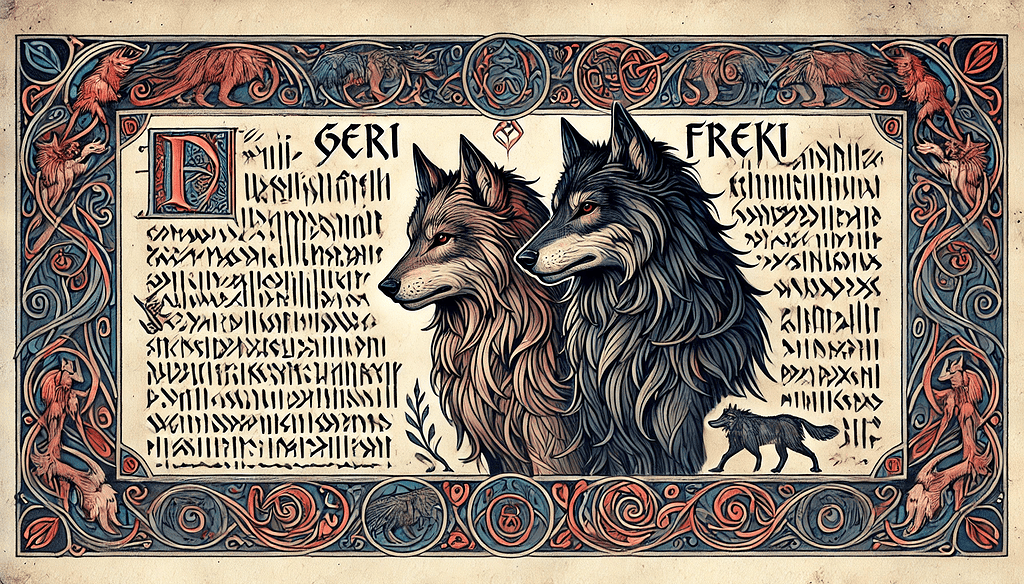
In Viking society, Geri and Freki were more than mere mythical creatures; they epitomized the virtues of the ideal warrior. Their characteristics of greed and ravenousness—though negative in a modern context—were admired traits for warriors, symbolizing a relentless pursuit of victory and glory.
These wolves mirror the aggressive, fearless nature that Norse warriors aspired to embody on the battlefield, demonstrating a clear alignment with the cultural ideals of strength and dominance.
Loyalty and guardianship are recurrent themes in Norse mythology, especially in the tales involving Geri and Freki. These wolves serve Odin with unwavering fidelity, never leaving his side, representing the ideal of loyalty that was paramount within Viking clans.
Their presence underscores the societal expectation for individuals to remain loyal to their leaders and protectors, much like Geri and Freki do for Odin.
Geri and Freki also bridge the gap between the divine realm and the everyday lives of Viking society. Their roles as Odin’s companions highlight the belief in the gods’ active involvement in the worldly affairs of men and nature.
This connection is particularly significant in illustrating how the Vikings perceived the integration of spiritual and practical aspects of life, with divine figures directly influencing their strategies, battles, and social structures.
The way Odin shares his food with Geri and Freki—giving them all the meat from his table while he himself consumes only wine—can also be seen as a reflection on the themes of survival and sacrifice.
This act is a powerful reminder of the harsh realities of life during the Viking Age, where survival often required sacrifice, a lesson that resonates through many aspects of Norse life from warfare to familial and community relationships.
Through these various lenses, Geri and Freki are seen not just as characters in myths but as profound symbols woven deeply into the fabric of Viking societal values.
Their portrayal in Norse mythology offers a vivid insight into the principles and beliefs that guided Viking society, emphasizing the traits of loyalty, strength, and the complex relationship between the divine and the earthly.
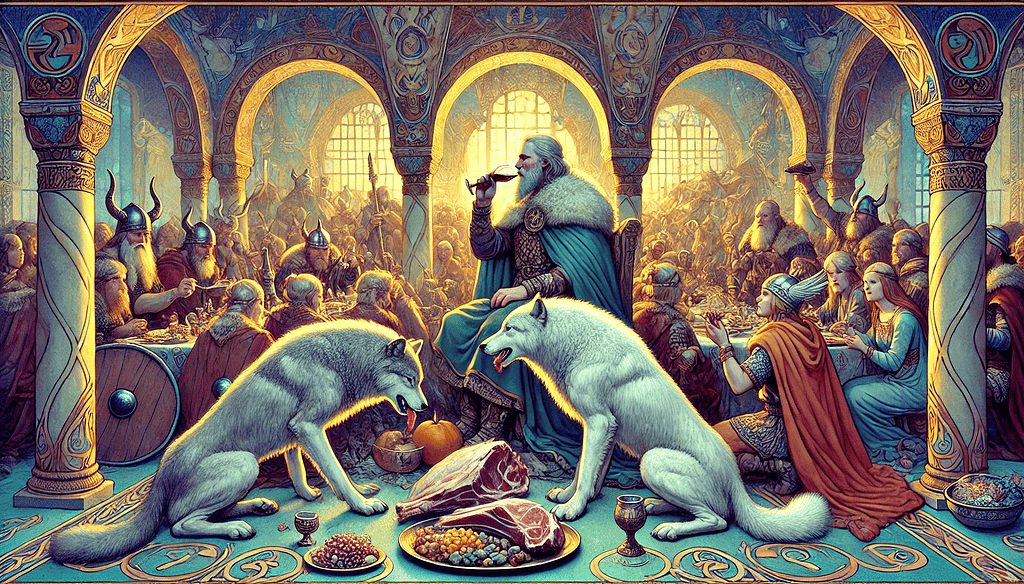
The enduring legacy of Geri and Freki in Norse mythology extends beyond their roles as mere companions of Odin. They embody the profound connections between the divine and the earthly, reflecting the values and beliefs of Viking society.
As symbols of loyalty, guardianship, and the warrior ethos, they continue to resonate in the modern interpretation of Norse myths, providing insights into the spiritual and cultural practices of the Norse people.
Their stories, rich with symbolic depth, invite us to explore the complex interplay between mythology, nature, and human values that defined the Norse worldview.